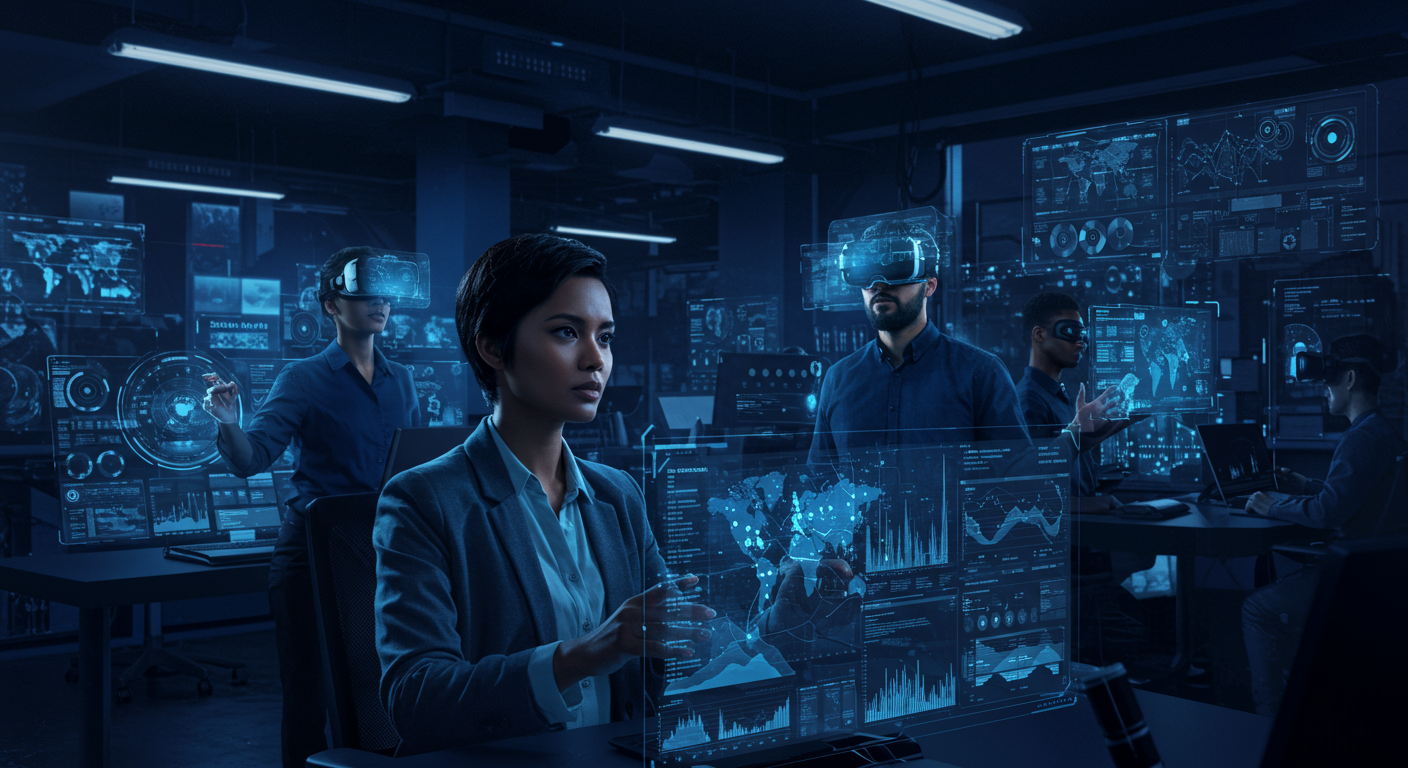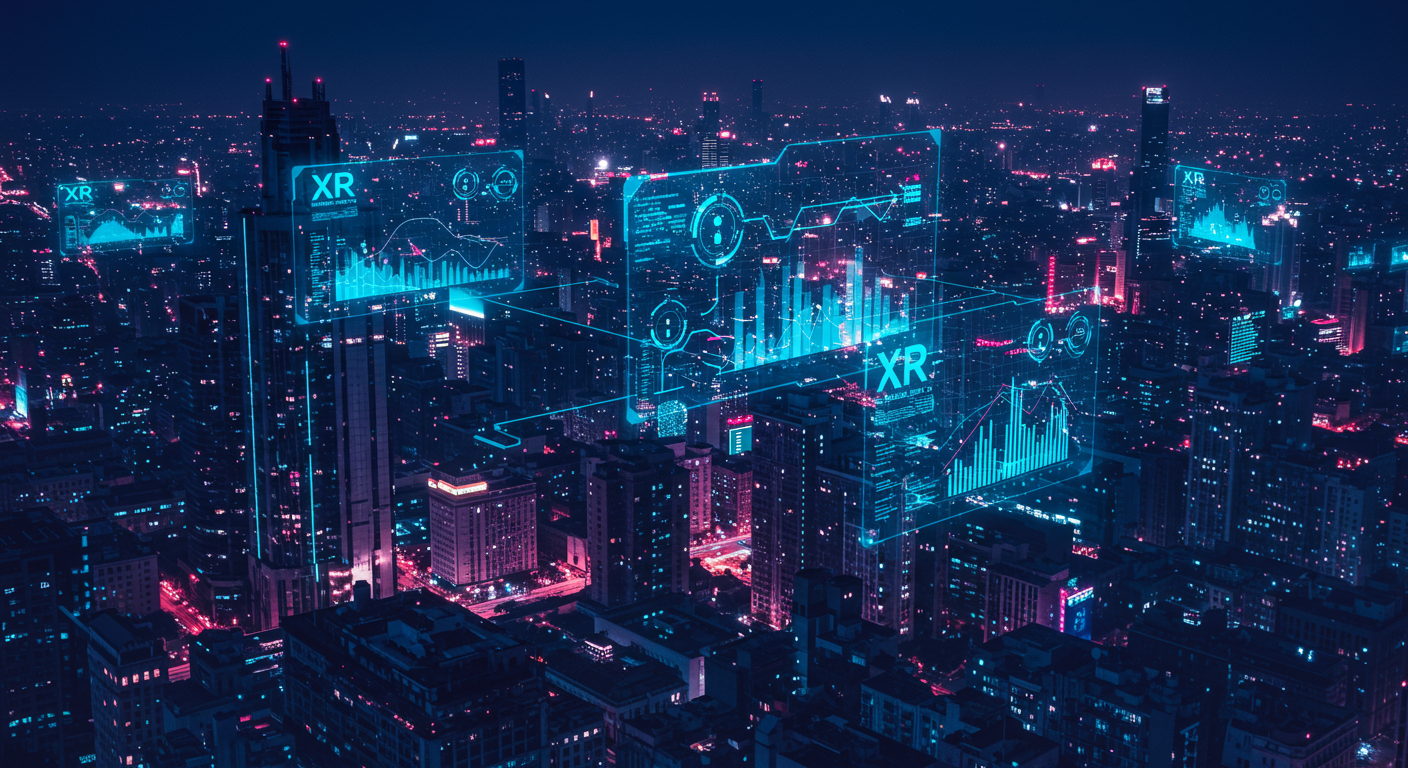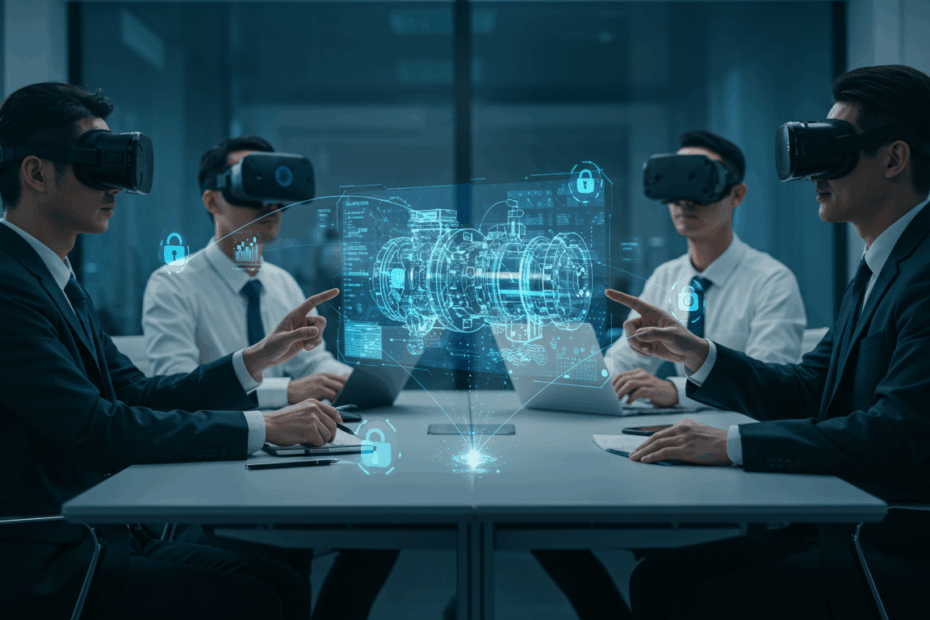The Enterprise Metaverse: Navigating the Immense Potential and Critical Risks of XR
John: It’s fascinating to watch a technology transition from a niche gadget for gamers into a cornerstone of enterprise strategy. That’s precisely where we are with Extended Reality, or XR. For years, it’s been a solution looking for a problem in the corporate world. Now, the problems are finding the solution, and businesses are waking up to its transformative power. But with that power comes a whole new dimension of responsibility, particularly around security.
Lila: I’m glad you started there, John. I feel like our readers hear “Metaverse” and “XR” and immediately picture sci-fi movies or video games. Before we dive into the deep end on security, could you give us a quick refresher? What exactly falls under this “XR” umbrella?
John: An excellent place to start. XR, or Extended Reality, is a catch-all term that covers all immersive technologies that merge the real and virtual worlds. Think of it as a spectrum. On one end, you have Virtual Reality (VR), which completely replaces your real-world environment with a digital one, like when you put on a headset and are transported to a virtual training facility. On the other end is Augmented Reality (AR), which overlays digital information onto your real-world view, think of a mechanic looking at an engine through their phone and seeing digital labels on each part. And in the middle, you have Mixed Reality (MR), which is a more advanced form of AR where digital objects are not just overlaid, but can actually interact with the real world.
Lila: So, it’s not just about escaping reality, but enhancing it. That makes the enterprise connection much clearer. Why is this blowing up in the business world right now, and not five years ago?
John: It’s a convergence of factors. The hardware has finally become powerful, comfortable, and affordable enough for scalable deployment. The software platforms have matured. And, frankly, the global shift towards remote and hybrid work created a massive demand for more effective collaboration tools than video calls. Enterprises are realizing they can train employees in safer, more cost-effective virtual environments, design and prototype products collaboratively in 3D space, and provide expert assistance to field technicians remotely. The ROI (Return on Investment) is no longer theoretical; it’s tangible.

Supply: Who is Building the Enterprise Metaverse?
Lila: That makes sense. It’s a perfect storm of need and capability. So who are the major players supplying this technology? When a Chief Technology Officer decides to explore XR, whose doors are they knocking on?
John: The ecosystem is broad, but you can break it down into a few key categories. On the hardware front, you have the big names everyone knows:
- Meta: Their Quest series, particularly with the “Quest for Business” subscription, is a very popular entry point due to its accessibility and price.
- Apple: The Vision Pro is positioned at the high end, focusing on premium “spatial computing” experiences with a strong emphasis on integration with their existing ecosystem.
- Microsoft: The HoloLens has been an enterprise-focused MR device from the start, deeply integrated with their Azure cloud and Dynamics 365 business applications.
- Specialists: Then you have companies like Varjo, who create ultra-high-fidelity headsets for industrial design and pilot training, and PICO, who have made significant inroads in the enterprise space as a strong competitor to Meta.
Lila: And the hardware is just the beginning, right? A headset is just a paperweight without the software.
John: Precisely. The software and platform layer is arguably even more critical. You have the foundational engines like Unity and Epic Games’ Unreal Engine, which are used to build the custom 3D experiences. Then you have enterprise-specific platforms. NVIDIA’s Omniverse is a powerful platform for creating and connecting 3D tools and applications, enabling things like industrial digital twins (a virtual model of a physical object or system). And crucially, you have XR device management platforms like ManageXR or ArborXR, which are essential for deploying and securing a fleet of devices at scale. Think of them as the IT department’s command center for their company’s headsets.
Technical Mechanism: What’s Under the Hood?
Lila: Okay, so we have the hardware and the software. I’m curious about the data. When I put on one of these headsets, what is it actually *doing*? How does it know where I am and what I’m looking at? It feels like magic, but I know it’s just very clever technology.
John: It’s incredibly clever. At its core, a modern XR headset is a sophisticated, wearable computer packed with sensors. You have IMUs (Inertial Measurement Units), which are gyroscopes and accelerometers that track the orientation and movement of your head. You have multiple cameras on the outside of the headset for what’s called inside-out tracking. These cameras constantly scan the room, creating a 3D map of the environment in real-time. This is how it knows where you are in physical space without needing external sensors set up around the room.
Lila: A 3D map of the room… that already sounds sensitive. What else is it collecting?
John: This is where we pivot directly into the security conversation, because the data collection is extensive. Beyond just mapping the room, these devices collect:
- Controller and Hand Tracking Data: It tracks the precise position of your hands and fingers, down to the millimeter.
- Eye-Tracking Data: More advanced headsets track where you are looking. This is used for foveated rendering (a technique to save processing power by only rendering what you’re looking at in high detail), but it also reveals what holds your attention.
- Facial and Body Tracking: Some systems can track facial expressions and body posture to animate an avatar, making virtual interactions more lifelike.
- Voice Data: The built-in microphones are always there for voice commands and communication.
- Biometric Data: This is the really sensitive stuff. Researchers have shown that unique patterns in head movement, eye-tracking, and even subtle physical mannerisms can be used as a “biometric signature,” a sort of digital fingerprint of your physical self.
Risks & Cautions: The New Frontier of Enterprise Security
Lila: Wow. That’s a staggering amount of personal and environmental data. My mind immediately goes to the risks. If a company is having a confidential design meeting in VR, or training employees in a virtual replica of their secure factory floor, that data being exposed would be catastrophic. It sounds like an absolute security nightmare.
John: You’ve hit the nail on the head. It is a new and complex threat landscape, and this is why, as many experts are now saying, XR security is no longer optional for the enterprise. The data these devices collect is a goldmine for malicious actors. We’re moving beyond traditional cybersecurity concerns like phishing emails and into a much more intimate domain.
The New Threat Landscape
Lila: Can you break down what those specific threats look like? What are the scenarios that should be keeping Chief Information Security Officers (CISOs) up at night?
John: Certainly. The threats are novel and multifaceted. Let’s look at the top concerns:
- Corporate Espionage & Data Exfiltration: Imagine an attacker gaining access to a virtual R&D meeting for a new prototype. They wouldn’t just hear the conversation; they could steal the 3D models right out of the virtual space. The risk of intellectual property theft is enormous.
- Biometric Data Harvesting and Deepfakes: This is a major one. As one security report noted, biometric signals can be harvested for identity modeling and deepfakes. An attacker could capture an executive’s unique biometric signature—their voice, mannerisms, facial expressions—and use it to create a convincing deepfake avatar to authorize a fraudulent transaction or spread misinformation.
- “Man-in-the-Room” Attacks: We’re used to “man-in-the-middle” network attacks. The XR equivalent is a “man-in-the-room” attack. If the spatial data from a headset is compromised, an attacker could have a complete 3D blueprint of a secure facility, a trading floor, or a CEO’s home office, including the location of whiteboards, documents, and computer screens.
- Persistent Ambient Listening: Every headset has a microphone. A compromised device could become a bug, capturing sensitive, proprietary conversations happening in the physical world, long after the virtual meeting has ended. This is a huge threat for trade secrets.
- Reality Distortion and Sabotage: In an AR context, a malicious actor could alter the digital information being displayed to a user. Imagine a technician being shown the wrong valve to turn off, or a surgeon being shown an incorrect incision line. The potential for physical harm or sabotage is very real.

The Enterprise XR Security Checklist: Are You Ready to Deploy?
Lila: That’s genuinely terrifying. It paints a clear picture of why this needs to be taken so seriously. So, for the companies that want to harness the power of XR but avoid these pitfalls, what’s the game plan? Is there an actionable checklist they can follow to ensure they’re ready to deploy XR securely?
John: Absolutely. A proactive, defense-in-depth strategy is crucial. Borrowing from traditional endpoint security and adapting it for XR is the key. A solid Enterprise XR Security Checklist should look something like this:
- Centralized Device Management: You cannot manage a fleet of 10, 100, or 1000 headsets individually. You need a dedicated XR Mobile Device Management (MDM) or Unified Endpoint Management (UEM) platform. This allows IT to enforce policies, deploy apps, wipe devices remotely, and control what features are enabled.
- Secure Network Configuration: Devices should never connect to an open guest Wi-Fi. They must be on a secure, segmented corporate network, ideally using a VPN (Virtual Private Network) to encrypt all traffic between the headset and company servers.
- Robust Identity and Access Management (IAM): Who is using this device? Don’t rely on simple PINs. Integrate with your company’s existing Single Sign-On (SSO) solution. Enforce multi-factor authentication (MFA) and apply the principle of least privilege, meaning users only have access to the apps and data essential for their job.
- Data Encryption and Residency: All sensitive data must be encrypted, both at rest on the device and in transit across the network. Furthermore, you need a clear policy on data residency. Where is that spatial map of your R&D lab being stored? Is it on the device, in your private cloud, or on a server in another country? For many industries, keeping that data within a specific geographic boundary is a legal requirement.
- Application Vetting and Kiosk Mode: Don’t allow users to download any application from the public app store. Create a curated, private app store with only vetted, company-approved applications. For many use cases, locking the device into a “kiosk mode” where it can only run a single, specific application is the most secure approach.
- Regular Security Audits and Penetration Testing: You have to treat your XR deployment like any other critical IT system. This means regular audits, vulnerability scanning, and hiring ethical hackers to perform penetration tests to find weaknesses before malicious actors do.
- User Education and Acceptable Use Policies: The human element is always a factor. Employees need to be trained on the unique security risks of XR. They need to understand what is and isn’t acceptable behavior, like not taking a work headset home and letting their kids play games on it.
Team & Community: Who Owns XR Security?
Lila: That checklist is incredibly comprehensive. It’s clear that this isn’t just a case of buying some headsets and handing them out. It also strikes me that this responsibility can’t fall on one person’s shoulders. You mentioned IT, CISOs… who in an organization needs to be in the room when planning an XR rollout?
John: That’s a critical point. XR deployment and security is a team sport. It cannot be siloed. Your IT and security teams are absolutely key to scaling XR in the enterprise, as they understand the existing infrastructure, security requirements, and data governance policies. But they can’t do it alone. The core team should include:
- The IT/Infrastructure Team: To handle network configuration, device management, and integration.
- The Cybersecurity Team: To assess risk, set security policies, and manage threat detection and response.
- The Legal and Compliance Team: To navigate the complex web of data privacy regulations like GDPR and CCPA, which absolutely apply to the data collected by XR devices.
- The Business Unit Leaders: The people who will actually be using the technology. They need to be involved to ensure the security measures don’t hinder the usability and effectiveness of the application.
- Human Resources: To help develop training programs and acceptable use policies for employees.
There are also vital external communities, like the AR for Enterprise Alliance (AREA), which works to create guidelines and best practices, helping companies navigate these challenges collectively. No one has to solve this alone.
Use-Cases & Future Outlook: The Reward for the Risk
Lila: We’ve spent a lot of time on the risks, and for good reason. But let’s pivot back to the “why.” Assuming a company follows the checklist and builds that cross-functional team, what are some of the truly powerful, game-changing use cases they can unlock?
John: This is the exciting part. When done securely, the applications are transformative. We’re seeing incredible success in several key areas:
- High-Stakes Training: Think surgeons practicing a complex procedure in a zero-risk virtual operating room, or airline pilots training for engine failure scenarios. It provides “hands-on” experience that is impossible to replicate safely or cost-effectively in the real world.
- Remote Expertise and Assistance: A junior technician at a remote wind turbine can wear AR glasses and stream their point of view to a senior expert thousands of miles away. The expert can see what they see and overlay instructions, diagrams, and circles onto their real-world view, guiding them through a complex repair.
- Collaborative Design and Prototyping: Automotive engineers from Germany, Japan, and the United States can all meet in a virtual space to walk around, inspect, and modify a full-scale 3D model of a new car. This drastically speeds up innovation cycles and reduces the need for expensive physical prototypes.
- Digital Twins of Operations: A company can create a living, breathing, data-fed virtual replica of its entire factory or supply chain. They can run simulations to identify bottlenecks, test new layouts, or predict maintenance needs without ever disrupting the real-world operation.
Lila: And looking forward, where does this go next? What’s the five-year outlook?
John: The future is about convergence. XR will become even more powerful when combined with other emerging technologies. AI will create smarter, more responsive virtual assistants and more realistic simulations. The Internet of Things (IoT) will feed real-time data from physical sensors into their digital twins. And 5G/6G networking will provide the high-bandwidth, low-latency connection needed to run these complex experiences on lighter, sleeker glasses, untethered from a powerful local computer. The “enterprise metaverse” will become less of a destination you go to and more of a digital layer that enhances every aspect of work.

Competitor Comparison: Is One Platform More Secure?
Lila: When companies are choosing a platform, how do they compare the big players on security? Is it as simple as saying an Apple Vision Pro is inherently more secure for business than a Meta Quest 3?
John: It’s not quite that simple. The security of a deployment is less about the brand name on the headset and more about the entire ecosystem: the hardware, the operating system, the management tools, and the corporate policies wrapped around it. Each major player has a different philosophy.
- Apple (visionOS): Their strategy is built on a foundation of privacy, with a heavy focus on on-device processing to minimize data sent to the cloud. Their “walled garden” ecosystem is tightly controlled, which can enhance security. However, this lack of openness can sometimes make integration with existing, diverse enterprise systems more challenging.
- Meta (Quest for Business): Meta’s platform is more open, which offers flexibility but places a greater onus on the enterprise to lock it down. Their model relies heavily on partnerships with leading UEM providers for the granular security and management controls that businesses require. The security is as strong as the management platform you integrate it with.
- Microsoft (HoloLens/Windows Holographic): Microsoft’s key advantage is its deep integration with the existing enterprise world. For a company that already runs on Windows, Azure, and Microsoft 365, the HoloLens is a natural extension. It leverages familiar security protocols and identity management systems, which can be a huge plus for IT teams.
The best choice depends entirely on a company’s existing IT ecosystem, risk tolerance, and specific use case.
Expert Opinions / Analyses
Lila: So what’s the consensus from the cybersecurity community? Are they optimistic, pessimistic, or just cautiously pragmatic?
John: The overwhelming consensus among security experts is one of cautious pragmatism. They are unanimous on one point: you must treat an XR headset not as a toy, but as a uniquely powerful and sensitive computing endpoint. It’s a corporate laptop, a smartphone, and a high-tech surveillance device all rolled into one. The potential for business transformation is immense, but it must be approached with a “security-by-design” mindset from day one.
Lila: So the old Silicon Valley mantra of “move fast and break things” is the absolute wrong approach here. If you “break” your security, you could be giving away the company’s crown jewels.
John: Exactly. This isn’t a social media app. For enterprises, the mantra must be “move thoughtfully and secure everything.” The initial investment in building a secure foundation will pay for itself many times over by preventing a single, devastating breach.
Latest News & Roadmap
Lila: What are some of the latest developments in this space that our readers should be watching?
John: The field is moving quickly. We’re seeing a push towards open standards, like OpenXR, which is a royalty-free standard from the Khronos Group. The hope is that standardized APIs (Application Programming Interfaces) will eventually make it easier to develop and secure applications that can run across different hardware. We’re also seeing the emergence of more sophisticated security analytics for XR, tools that can detect anomalous behavior in a virtual environment, just as they do on a traditional network. Finally, for government and defense sectors, there’s a growing interest in “sovereign metaverses,” which are private, highly-secure virtual environments where all data and infrastructure are under the complete control of the organization, ensuring nothing leaves their jurisdiction.
Frequently Asked Questions (FAQ)
Lila: Okay, let’s wrap up with a quick-fire FAQ section for anyone scanning for the key takeaways. First up: What is the single biggest security risk with enterprise XR?
John: In a word: data. Specifically, the exfiltration (unauthorized transfer) of the unique and highly sensitive data these devices collect. The combination of spatial maps of secure locations, biometric user data, and proprietary business information in one place makes it an incredibly high-value target.
Lila: Next question. Can a small business just use off-the-shelf consumer VR headsets for work?
John: While technically possible, it’s highly discouraged from a security standpoint. Consumer devices and accounts often lack the necessary management controls, data encryption settings, and policy enforcement capabilities. They are designed for individual use, not for a secure, managed corporate environment. Using them without a proper XR device management platform is inviting risk.
Lila: Last one. How can an employee or mid-level manager convince their leadership to invest properly in XR security?
John: Frame the conversation around risk and enablement. It’s not an expense; it’s an insurance policy and a business enabler. Calculate the potential financial and reputational cost of a data breach involving your most sensitive intellectual property. Compare that to the cost of a robust security and management platform. A secure deployment is what enables you to confidently unlock the massive productivity gains and ROI that XR promises.
Related Links
Lila: And for those who want to do a deeper dive, where can they go to learn more?
John: There are some excellent resources out there. I would recommend starting with these:
- The AR for Enterprise Alliance (AREA): They publish a wealth of research, best practices, and safety/security guidelines specifically for enterprise adoption.
- The Khronos Group: For those interested in the underlying technology, they manage the OpenXR standard.
- Major Tech News Outlets: Sites like XR Today, Road to VR, and UploadVR often cover enterprise news and security topics in depth.
- Your UEM/MDM Provider: If your company already uses a major endpoint management solution (like Microsoft Intune, VMware Workspace ONE, etc.), check their documentation for their latest XR device support and security features.
John: Ultimately, the journey into the enterprise metaverse is a perfect example of the classic technology paradox. It offers unprecedented opportunities for innovation, collaboration, and efficiency. But it also presents novel and complex risks that must be managed with diligence and foresight. The companies that succeed will be the ones that embrace the potential without ever losing sight of the peril.
Lila: A balance of bold vision and responsible execution. It seems like the future of work is going to be a lot more immersive, and hopefully, a lot more secure. Thanks, John.
Disclaimer: This article is for informational purposes only and does not constitute financial or investment advice. The views expressed are those of the authors. Always conduct your own thorough research (DYOR) before making any decisions related to technology adoption or investment.
